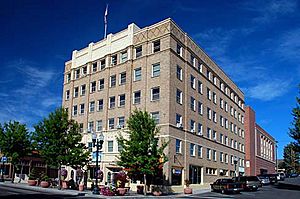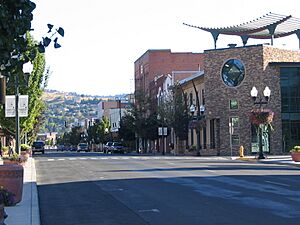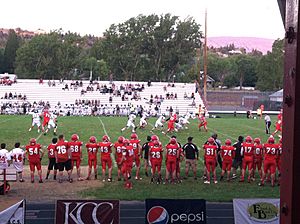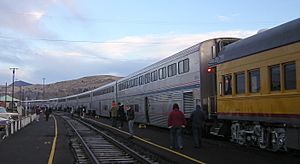Klamath Falls, Oregon facts for kids
Quick facts for kids
Klamath Falls, Oregon
|
|
|---|---|
 |
|
| Nickname(s):
Oregon's City of Sunshine
|
|
| Motto(s):
"Working For You"
|
|

Location in Oregon
|
|
| Country | United States |
| State | Oregon |
| County | Klamath |
| Incorporated | 1905 |
| Area | |
| • Total | 20.96 sq mi (54.27 km2) |
| • Land | 20.08 sq mi (52.01 km2) |
| • Water | 0.88 sq mi (2.27 km2) |
| Elevation | 4,094 ft (1,248 m) |
| Population
(2020)
|
|
| • Total | 21,813 |
| • Density | 1,086.30/sq mi (419.43/km2) |
| Time zone | UTC−8 (Pacific) |
| • Summer (DST) | UTC−7 (Pacific) |
| ZIP codes |
97601, 97603
|
| Area code(s) | 541 |
| FIPS code | 41-39700 |
| GNIS feature ID | 2411554 |
| Website | City Website |
Klamath Falls is a city in Oregon, United States. It is the main city and county seat of Klamath County. The city was first called Linkville when it was founded in 1867 by George Nurse. It was named after the Link River. The name was changed to Klamath Falls in 1893.
In 2020, about 21,813 people lived in Klamath Falls. The city is located on the southeastern shore of Upper Klamath Lake. One of the first big industries in Klamath Falls was logging, which means cutting down trees for wood.
Contents
A Look Back at Klamath Falls' History
How Klamath Falls Got Its Name
When the city was founded in 1867, it was called Linkville. This name came from the Link River. Later, between 1892 and 1893, the name was changed to Klamath Falls. The word Klamath might come from a word meaning "people" in the Chinookan languages, used by local indigenous peoples of the Northwest Plateau to describe the area.
Early Days and Important Events
The first known people to live in this area were the Klamath and Modoc tribes. The Modoc people's homeland was south of Klamath Falls. They were forced to live on a reservation with the Klamath, who were their rivals. This led to a conflict called the Modoc War in 1872–1873. The Modoc people hid in nearby Lava Beds National Monument. This war was very costly for the US Cavalry.
In 1846, the Applegate Trail was created. This trail went through the Klamath area and offered a safer way for people traveling on the Oregon Trail. The first non-Native American settler was Wallace Baldwin in 1852. In 1867, George Nurse named the small settlement "Linkville."
A big project called the Klamath Reclamation Project started in 1906. Its goal was to drain marshland and move water to help with farming. Water first became available for farms on May 22, 1907. After World War I and World War II, soldiers were given land here to start farms.
During World War II, a Japanese-American internment camp called the Tule Lake War Relocation Center was located nearby. Also, a small part of a POW camp was near the Oregon–California border. In May 1945, a Japanese Fu-Go balloon bomb landed near Bly, Oregon, east of Klamath Falls. Sadly, it caused the only deaths on the US mainland during the war, killing a woman and five children.
Logging was a very important industry in Klamath County for many years. When the Southern Pacific Transportation Company railroad arrived in 1909, Klamath Falls grew very fast. Many lumber mills cut down fir and pine trees. This industry was strong until the late 1980s. Changes in forest rules, partly because of animals like the northern spotted owl, affected the timber industry.
On September 20, 1993, a series of earthquakes hit near Klamath Falls. Many buildings in the downtown area were damaged or destroyed, and two people lost their lives.
Using Earth's Heat: Geothermal Heating
Klamath Falls is in an area with a lot of geothermal power. This means there's heat from deep inside the Earth. People have used this natural heat for geothermal heating since the early 1900s.
In 1981, a heating system for the downtown area was built. It uses hot water from underground to heat homes, schools, and other buildings. It even helps melt snow on sidewalks and roads! At first, some people worried that the city's system might affect their private geothermal wells. But studies showed it did not cause problems. The system has grown and now helps many parts of the city.
Keeping the Air Clean
The Oregon Department of Environmental Quality reported in 2012 that people are working hard to make the air quality better in the Klamath area.
Klamath Falls' Location and Climate
Where is Klamath Falls?
Klamath Falls covers about 20.66 square miles (53.51 square kilometers). Most of this area is land, and a small part is water. The city is about 4,094 feet (1,248 meters) above sea level.
The area around Klamath Falls is like a high desert. The older parts of the city are built over natural geothermal springs, which provide the heat mentioned earlier.
Weather in the "City of Sunshine"
Klamath Falls is known as "Oregon's City of Sunshine" because it gets about 300 sunny days each year! The climate is a high desert type. This means it has cold, snowy winters. Summers have hot afternoons but cool nights.
Even though it's a high desert, Klamath Falls gets some rain and snow. It gets about 13.41 inches (341 mm) of precipitation each year. This is because the city is in the "rain shadow" of the Cascade Mountains to the west. This means the mountains block a lot of the rain.
On average, Klamath Falls gets about 36.5 inches (93 cm) of snow each winter. The hottest temperature ever recorded was 105°F (41°C) in July 1911. The coldest was -24°F (-31°C) in January 1888.
| Climate data for Klamath Falls, Oregon (1991–2020 normals, extremes 1897–present) | |||||||||||||
|---|---|---|---|---|---|---|---|---|---|---|---|---|---|
| Month | Jan | Feb | Mar | Apr | May | Jun | Jul | Aug | Sep | Oct | Nov | Dec | Year |
| Record high °F (°C) | 78 (26) |
69 (21) |
77 (25) |
87 (31) |
98 (37) |
103 (39) |
103 (39) |
104 (40) |
103 (39) |
92 (33) |
74 (23) |
63 (17) |
104 (40) |
| Mean maximum °F (°C) | 53.1 (11.7) |
58.4 (14.7) |
67.8 (19.9) |
75.6 (24.2) |
83.4 (28.6) |
90.7 (32.6) |
96.3 (35.7) |
95.1 (35.1) |
89.5 (31.9) |
78.8 (26.0) |
65.1 (18.4) |
51.9 (11.1) |
97.6 (36.4) |
| Mean daily maximum °F (°C) | 41.5 (5.3) |
46.3 (7.9) |
52.3 (11.3) |
57.8 (14.3) |
67.2 (19.6) |
76.2 (24.6) |
86.3 (30.2) |
84.8 (29.3) |
77.5 (25.3) |
64.2 (17.9) |
49.1 (9.5) |
40.3 (4.6) |
62.0 (16.7) |
| Daily mean °F (°C) | 31.5 (−0.3) |
34.9 (1.6) |
39.4 (4.1) |
43.5 (6.4) |
51.7 (10.9) |
58.8 (14.9) |
67.1 (19.5) |
65.6 (18.7) |
58.2 (14.6) |
47.4 (8.6) |
37.0 (2.8) |
30.4 (−0.9) |
47.1 (8.4) |
| Mean daily minimum °F (°C) | 21.5 (−5.8) |
23.5 (−4.7) |
26.5 (−3.1) |
29.1 (−1.6) |
36.2 (2.3) |
41.4 (5.2) |
47.8 (8.8) |
46.5 (8.1) |
39.0 (3.9) |
30.7 (−0.7) |
24.9 (−3.9) |
20.6 (−6.3) |
32.3 (0.2) |
| Mean minimum °F (°C) | 5.7 (−14.6) |
10.8 (−11.8) |
16.1 (−8.8) |
19.5 (−6.9) |
24.8 (−4.0) |
30.9 (−0.6) |
39.1 (3.9) |
38.4 (3.6) |
29.3 (−1.5) |
19.8 (−6.8) |
11.1 (−11.6) |
6.2 (−14.3) |
−1.0 (−18.3) |
| Record low °F (°C) | −25 (−32) |
−12 (−24) |
−5 (−21) |
10 (−12) |
17 (−8) |
23 (−5) |
22 (−6) |
28 (−2) |
20 (−7) |
8 (−13) |
−7 (−22) |
−20 (−29) |
−25 (−32) |
| Average precipitation inches (mm) | 1.51 (38) |
1.12 (28) |
1.03 (26) |
1.06 (27) |
1.04 (26) |
0.66 (17) |
0.22 (5.6) |
0.28 (7.1) |
0.30 (7.6) |
0.74 (19) |
1.38 (35) |
1.80 (46) |
11.14 (282.3) |
| Average snowfall inches (cm) | 8.1 (21) |
4.2 (11) |
2.2 (5.6) |
0.2 (0.51) |
0.1 (0.25) |
0.0 (0.0) |
0.0 (0.0) |
0.0 (0.0) |
0.0 (0.0) |
0.3 (0.76) |
3.2 (8.1) |
13.4 (34) |
31.7 (81.22) |
| Average precipitation days (≥ 0.01 in) | 10.9 | 9.4 | 10.7 | 9.1 | 8.4 | 4.7 | 1.6 | 2.4 | 2.6 | 5.6 | 10.4 | 12.2 | 88.0 |
| Average snowy days (≥ 0.1 in) | 3.9 | 2.5 | 1.5 | 0.2 | 0.0 | 0.0 | 0.0 | 0.0 | 0.0 | 0.1 | 2.1 | 4.7 | 15.0 |
| Source: NOAA (snowfall 1981–2010) | |||||||||||||
People and Community
| Historical population | |||
|---|---|---|---|
| Census | Pop. | %± | |
| 1880 | 250 | — | |
| 1890 | 364 | 45.6% | |
| 1900 | 447 | 22.8% | |
| 1910 | 2,758 | 517.0% | |
| 1920 | 4,801 | 74.1% | |
| 1930 | 16,093 | 235.2% | |
| 1940 | 16,497 | 2.5% | |
| 1950 | 15,875 | −3.8% | |
| 1960 | 16,949 | 6.8% | |
| 1970 | 15,775 | −6.9% | |
| 1980 | 16,661 | 5.6% | |
| 1990 | 17,737 | 6.5% | |
| 2000 | 19,480 | 9.8% | |
| 2010 | 20,840 | 7.0% | |
| 2020 | 21,813 | 4.7% | |
| Sources: U.S. Decennial Census 2018 Estimate |
|||

In 2010, there were 20,840 people living in Klamath Falls. The city had 8,542 households. About 30.4% of these households had children under 18. The average age in the city was 33.6 years old.
The people living in Klamath Falls come from many different backgrounds. In 2010, about 83.4% of the people were White, 4.3% were Native American, and 11.8% were of Hispanic or Latino background.
Fun and Learning in Klamath Falls
Parks and Outdoor Fun
Klamath Falls has many parks and outdoor areas to enjoy.
- Moore Park has a network of trails for walking and biking.
- OC&E Woods Line State Trail is a long trail built on an old railroad line. It's the longest state park trail in Oregon.
- Veterans Memorial Park is located downtown along Lake Ewauna.
Klamath Falls is also on the Pacific Flyway, which is a major route for birds. You can often see many different kinds of waterfowl, raptors, and American white pelican here.
Schools and Colleges
Klamath Falls has many schools for students of all ages.
- Colleges and Universities:
- College of Cosmetology
- Klamath Community College
- Oregon Institute of Technology
- Public Schools:
- Klamath County School District
- Klamath Falls City School District
Staying Connected: Media and Transportation
Radio Stations
Klamath Falls has many radio stations that play different types of music and news.
- FM Stations:
- 88.5 FM - KLMF (JPR classics & news)
- 88.9 FM - KJKF (Contemporary Christian Music)
- 89.5 FM - KTEC (College Freeform from Oregon Institute of Technology)
- 89.9 FM - K210BY (Christian)
- 90.5 FM - K213AI (JPR news & information)
- 90.9 FM - KSKF (JPR rhythm & news)
- 91.5 FM - K218EX (Spanish Christian)
- 91.9 FM - K220BJ (JPR news & information)
- 92.5 FM - KLAD-FM (Country music)
- 92.9 FM - K225CW (News/Talk)
- 93.3 FM - K227CU (Rock)
- 94.9 FM - KAGO-FM (Rock)
- 96.5 FM - KFLS-FM (Country music)
- 97.1 FM - K246BB (Christian)
- 97.5 FM - KYSF (Christian Worship Music)
- 98.5 FM - KHIC (Top 40)
- 99.5 FM - KFXX-FM (Classic Hits)
- 99.9 FM - K260AK (Christian)
- 100.7 FM - KLKF (Contemporary Christian Music)
- 101.3 FM - K267CF (Christian)
- 102.5 FM - K273DF (News/Talk)
- 104.3 FM - K282CB (Sports Radio)
- 104.7 FM - KFEG (Classic Rock)
- 105.5 FM - KKKJ (Top 40)
- 106.5 FM - K293CQ (Regional Mexican)
- 106.9 FM - KKRB (Adult Contemporary)
- AM Stations:
- 960 AM - KLAD (Sports)
- 1150 AM - KAGO (News/Talk)
- 1240 AM - KRJW (Sports)
- 1450 AM - KFLS (News/Talk)
Television Stations
You can watch these TV channels in Klamath Falls:
- Channel 2 KOTI - NBC
- Channel 15 K15KE-D KTVL - CBS
- Channel 22 KFTS - PBS
- Channel 30 K31NH KBLN-TV - 3ABN
- Channel 31 KDKF - ABC
- Channel 48 K26NB-D KFBI-LD - MNT
Getting Around: Transportation
- Train: The national passenger train system, Amtrak, has a station in Klamath Falls. The Coast Starlight train travels daily through here, connecting Seattle, Washington and Los Angeles, California.
- Buses: Basin Transit Service provides local bus service. You can also take Oregon POINT buses to other cities like Medford. Sage Stage offers weekly service to Alturas, California.
- Airport: The Klamath Falls airport is about 6 miles (10 km) south of downtown. It's also home to a military airbase. The closest airport for regular flights is Rogue Valley International-Medford Airport, which is 78 miles (126 km) away.
Kingsley Field Air National Guard Base
Kingsley Field Air National Guard Base was started in 1928. It is home to the 173rd Fighter Wing of the Oregon Air National Guard. They fly F-15 C/D fighter jets. The base has the second-longest runway in Oregon and was even listed as a backup landing strip for the Space Shuttle. You might hear the jets flying over Klamath Falls during the day!
Famous People from Klamath Falls
Many interesting people have connections to Klamath Falls, including:
- Sharron Angle (born 1949), a politician from Nevada.
- Brenda Bakke (born 1963), an actress.
- Dennis Bennett (1939–2012), a Major League Baseball player.
- Ernest C. Brace (1931–2014), a pilot.
- Jeff Bronkey (born 1965), a Major League Baseball player.
- Seth Brown (born 1992), a Major League Baseball player for the Oakland Athletics.
- Don Pedro Colley (1938–2017), an actor.
- Ian Dobson (born 1982), an Olympic runner and coach.
- Christine Drazan (born 1972), an Oregon politician.
- Chris Eyre (born 1968), an award-winning film director.
- Helen J. Frye (1930–2011), a Federal District Court judge.
- Chad Gray (born 1971), a musician.
- Rosie Hamlin (1945–2017), a singer-songwriter.
- Ralph Hill (1908–1994), an Olympic silver medalist in running.
- James Ivory (born 1928), an Oscar-winning director and screenwriter.
- Dan O'Brien (born 1966), an Olympic gold medalist in the Decathlon.
- Laurenne Ross (born 1988), a World Cup alpine ski racer.
- Janice Romary (1927–2007), an Olympic fencer who was the first woman to compete in six Olympic Games.
- Kim Walker-Smith (born 1981), a worship leader and recording artist.
Sister City
Klamath Falls has one "sister city," which means it has a special friendship with a city in another country:
Images for kids
See also
 In Spanish: Klamath Falls para niños
In Spanish: Klamath Falls para niños






